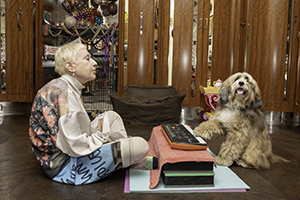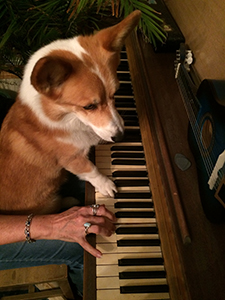Music Therapy Hits a High Note
By Muriel Adams
Adog tinkles two keys of a piano with its paw. Some $200,000 is raised for a project, Music for Cats. Pets’ massage experiences are enriched with Bach in the background.
Indeed, “music has the charms to sooth the savage beast,” as the saying goes. And, just as Bach or Schubert may be calming to humans, their music can calm their hounds, too.

“Don’t forget that pets can stress out, “ says Jessica Vogelsang, DVM, located in San Diego, who has a website, pawcurious, and published a memoir, All Dogs Go to Kevin. In fact, the practice of music therapy for pets is now being used more frequently. “Even just a few years ago, music therapy was rarely used for pets,” says Vogelsang. “Both owners and pet care professionals are starting to understand the significant impact sound can have on a pet’s mental state.”
Manhattan dog guardian Elisabeth Weiss, owner of two Briards, Zeldi, three and a half, and Snoori 18 months, has used music therapy for companion animals for nine years. “I was a classical musician and saw that my dog immediately relaxed when I played the violin,” says Weiss. A client, a very nervous Briard girl named Cosi, responded very well to the piano. The dog had been overdosed at the vet and suffered neurological deficit, Weiss explains. “With training, she would touch the keys of the piano with her nose or paws and found it very calming. Cosi could even play a couple notes. Her self-confidence increased. When a dog like her begins to interact with her environment, the dog is not so scared.”
Another example of the therapeutic effect of music on dogs was Lou Reed and Laurie Anderson’s Rat Terrier, Lollabelle, who eventually died of pancreatic cancer. “Lolabelle was able to jam on the keyboard and that gave her tremendous lust for life. She survived two years longer rather than the short time she was given after diagnosis and surgery,” says Weiss.
Music therapy can be tried where possible instead of medication, explains Ann Hohenhaus, DVM, at Manhattan’s Animal Medical Center. She says, “If music therapy works, that’s great. Then we don’t need medications.” One of her clients was a dog anxious traveling in a car. “In the car they played a calming CD and after a while everyone was ready for a nap,” she says, laughing. “But it did keep the dog calm!” She finds Amazon.com the biggest resource for therapeutic music for pets.

As for cats, Hohenhaus cites a study, regarding music and anesthesia. Heavy metal-stimulated cats needed more anesthesia; when gentle music was played, the cats needed less. “Birds,” says Hohenhaus, “need a lot of stimulation so people leave the radio or TV or a You Tube video on for them.” Videos she says, have helped with the “craziness” of shelters, too.
Sally Morgan, a holistic physical therapist for pets (and people) and author of Dances of the Heart—Connecting with Animals, finds Bach a good choice for all animals because its rhythm and repeating pattern help to engage both hemispheres of the brain and slows the heart rate. She is, too, a proponent of music composed specifically for the auditory spectrum of animals. Through a Dog’s Ear are CDs with music using frequencies to calm a dog’s nervous system. “This music has been very effective in calming the dogs I work with, or in a group with many dogs together to help reduce stress.”
A set of CDs, Wholetones Healing Frequencies Music, is similar, according to Morgan. “These are very long sustained tones woven together and purported to bring a sense of peace.” Says Morgan, “Calming music has been used in shelters, barns, and homes to help animals relax. Nearly every animal massage therapist I know uses music during sessions, as do I.”
Hohenhaus likes the cat-specific classical music composed by David Teie, a prominent cellist and composer who raised more than $200,000 for a Music for Cats classical music project. Concert pianist Lisa Spector, known as The Pet Calming Maestro, and psychoacoustics researcher Joshua Leeds, (a Juilliard graduate, pianist and composer) found, through research, that dogs prefer classical music played one octave lower than what humans listen to. The result was a series of CDs, Through a Dog’s Ear.

Juilliard graduate Susan Raimond established a harp enrichment program for animals, which Vogelsang softly plays in the background during especially stressful euthanasia appointments. “It calms everyone in the room, both human and animal. It’s as if it absorbs the stress and floats it away,” says Vogelsang.
Dogs do have sensitivity to sound, says Dr. Karen Walwyn, Steinway Artist and Associate Professor at Howard University, Washington, D.C. Walwyn is working with Dr. Leslie Sinn, an animal psychologist, to experiment and see which of Walwyn’s compositions resonate best with dogs. “Music,” says Sinn, “is very helpful for calming different anxieties, such as environmental, separation and noise.” See how it works: classicalforpets.com/watch-how-it-works-1
Dogs can even be picky when it comes to music they will or will not listen to. When Walwyn’s late German Shepherd Miles was young, he sat on her lap or under her feet as she practiced piano. “Once, my then-husband entered the room playing the trumpet. Miles walked off. He didn’t like the sound. He never went to sit next to him. Once, I began singing. His eyes said: Have you lost your mind? Miles turned around and walked out of the room. When I started playing the piano again, he came back.”












